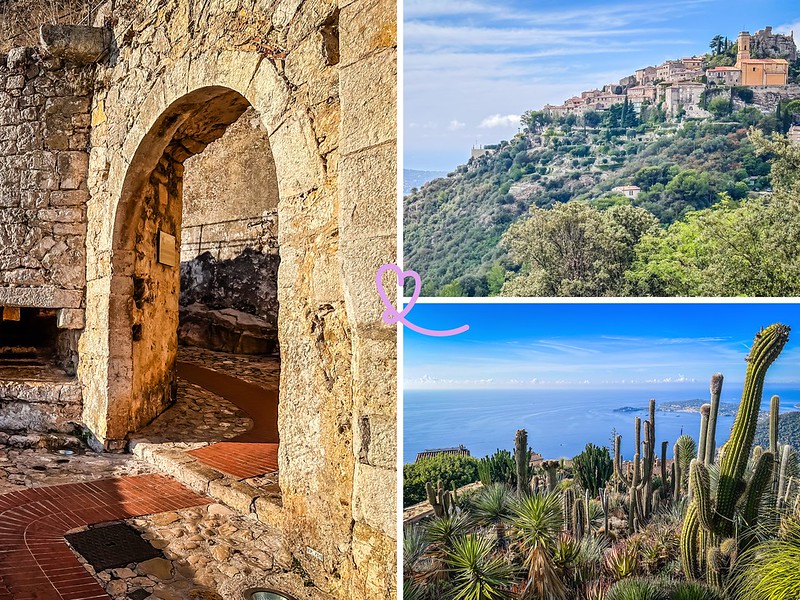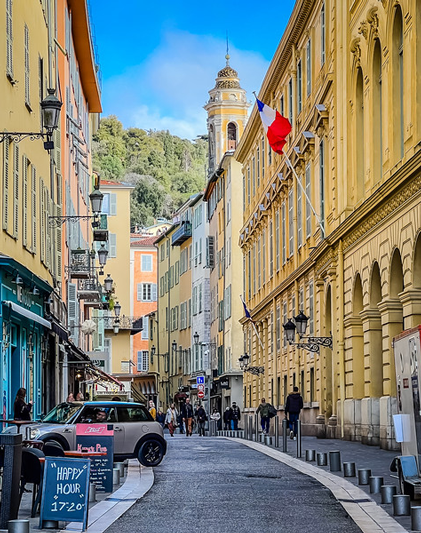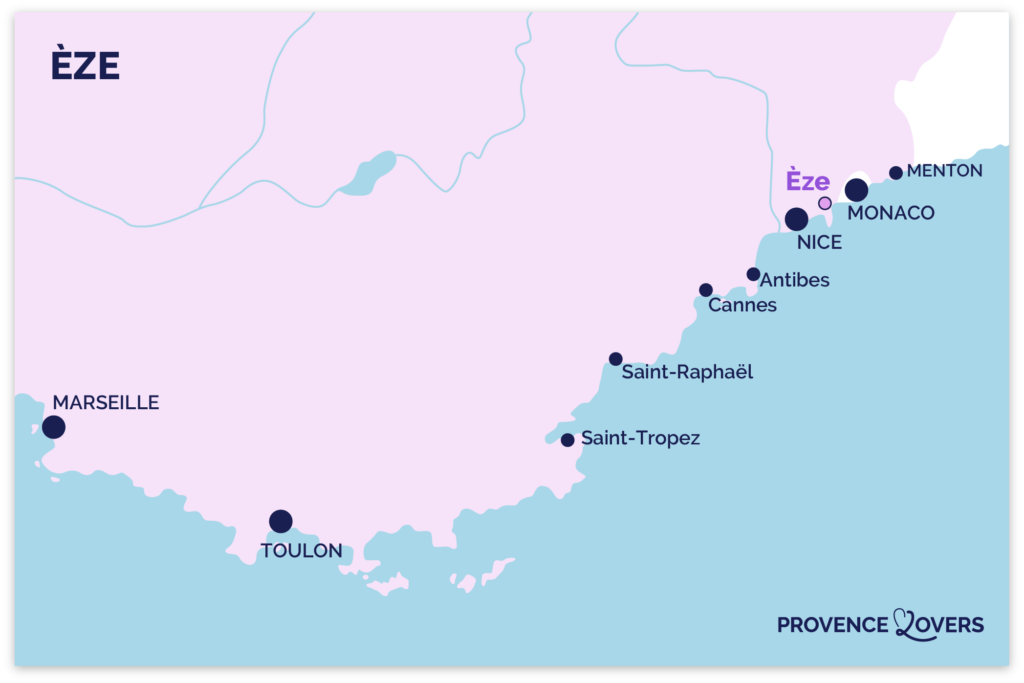We invite you to discover the charming village of Èze, a true jewel of the Côte d’Azur, which has filled us with wonder. Nestled on a cliff overlooking the Mediterranean Sea, this village offers a medieval ambience, cobbled streets, lush gardens and breathtaking panoramic views.
Here’s our complete guide to planning your visit to the village of Èze: how to get there, things to do, practical tips and our own photos!

This guide is completely independent, based on our experiences. We visited the region anonymously, making our own choices and paying our bills in full.
Visit the village of Èze: map + essential information
You’ll find all our practical tips at the end, but for a quick answer, here’s what you need to know:
- As this is a very touristy place, we advise you to come before 10 a.m. to make the most of the narrow streets.
- Sloping village with stairs, but fairly easy ground
- Allow at least 2 hours for the village and garden. But half a day seems more appropriate to enjoy it.
- Access to the village is free, but there is a charge to enter the garden (if you arrive in the middle of the day, pick up a ticket at one of the kiosks to avoid queuing at the entrance).

- Note that the station is at beach level, but the village is at an altitude of 429m. If you’re not coming by car, you’ll need to take a bus from Nice or from the train station.
- Underground pay parking lot at the entrance to the village and another further on with shuttle bus.
- There are also organized tours departing from Nice – see program
- If you can, we recommend a one-night stay for a timeless experience! At the Château Eza hotel, for example – see photos and availability
And now, let’s enter this magnificent medieval village, one of the most beautiful on the Côte d’Azur(see our list) and discover the things to see…

1. The postern at the entrance to the village
And the adventure begins at the postern. It is a defensive device integrated into the village ramparts. As you can see, there’s a double-gate system, protected by two towers and a drawbridge.
In the 16th century, this defensive system proved inadequate against Barbarossa’s Franco-Turkish attack. They succeeded in occupying the village.

2. Explore medieval alleyways
Next, discover the pretty medieval streets surrounded by magnificent stone houses.
The village is very well maintained and has a real time-travel atmosphere. We were very pleasantly surprised, as we had some preconceptions due to the popularity of the place.
We strongly advise you to come early in the morning to explore the alleyways before the tourist rush. So you can admire the details, enjoy the plants and the perspectives.

There are lots of staircases and alleyways in every direction.
However, the village is quite small. So you won’t get lost. On the contrary, it’s great fun to wander down alleys at random, wondering what you’ll see at the other end.
What’s more, the houses are close together, with tunnels to cross in some places.
As you can see from our photos, they’ve really succeeded in preserving the village’s medieval character. This is not often the case.

3. Visit the exotic garden
The village’s other attraction is its magnificent botanical garden, which you enter practically at the top of the village.
Beware, there are still a lot of stairs to explore, but it’s well worth it. This is one of the most beautiful gardens on the Côte d’Azur.
Here you’ll discover numerous cacti, succulents, statues and splendid sea and mountain views.

- Price: 7 euros for adults (4 euros for teenagers and free for children under 12)
- open at least from 9 a.m. to 4:30 p.m. in winter and 9 a.m. to 6:30 p.m. in summer
- see the official website here
- if you arrive during the day, take a ticket from one of the kiosks in the village to avoid queuing at the entrance to the garden
More photos in our garden article.

OUR TPS FOR RENTING YOUR CAR IN Provence
- Compare prices on our preferred platform: DiscoverCars – one of the best rated sites.
- Choose a car that is powerful enough (the roads are steep) but compact (some passages are narrow).
- Think of thecomplete insurance (some roads are tortuous and narrow).
- There is a lot of demand, book it early.

4. Castle ruins
In the garden, at the very top of the village, you’ll discover the ruins of the castle. It is the highest point in the village at 429m. All that remains of this 12th-century building are a few pieces of wall.
The fort was destroyed by order of Lousi XIV in 1706.
But from this promontory, you can enjoy magnificent views in all directions: the sea, the mountains, the viaduct…
You’ll also find beautiful sculptures by artist Jean-Philippe Richard.

5. Notre-Dame-de-l’Assomption church
At the side of the village, take time to discover the Notre-Dame-de-l’Assomption church. It was built between 1763 and 1772, based on an earlier structure.
The tower and bell tower, with their blue dial, were built later in the 19th century.

Start by admiring its neo-classical façade with 4 columns.
Then enter, and discover the Baroque décor with its many paintings and gildings. We were a bit shocked by the contrast with the facade!
Don’t miss the statue of Notre Dame de l’Assomption.
Find out more in our article on the church.

6. Chapelle Sainte-Croix (white penitents)
In the narrow streets, don’t miss the Sainte-Croix chapel, known as the Pénitents Blancs. This is one of the oldest buildings in the commune.
It was founded in 1306. There were major plague epidemics at the time. White penitents were lay people who performed acts of penance by assisting the sick (wearing white hoods).

The chapel is enclosed by a gate. But when the door is open, you can still see inside.
Some of the elements in the chapel look intriguing, but we didn’t see any of them.

7. Lunch in this charming place – where to eat in Èze
In the village, you’ll find different types of restaurant: tucked away in the narrow streets surrounded by stone houses, or with a terrace and panoramic views.
The village is renowned for its gourmet cuisine:
- Restaurant La Chèvre d’Or (2 stars)
- Restaurant Château Eza (1 star)
But also more accessible restaurants: Les Remparts, le café du jardin…
And at the bottom of the village, you’ll find other nice options like the L’Echoppe Provençale restaurant.

8. Spend a timeless night in one of our hotels
The two hotels inside the medieval village are luxury establishments. But they’re worth the detour.
A night in this village offers a unique experience, like a journey back in time with unforgettable views.
Walking around the village at night is a privilege. What if walls could talk?
You have:
- Hotel Chateau Eza – see photos and availability
- Hotel La Chèvre d’Or – see photos and availability
Otherwise, two towns are close by and offer great options for a stay:
- The great city of Nice, a 30-minute drive away – see our selection of the best hotels
- Beaulieu-sur-Mer, a peaceful town 15 minutes away (hotel selection coming soon)

9. Èze hike: Nietzsche trail
Outside the village, if you like walking, you can take the Nietzsche Trail up or down. It links the village with the beach. A bus also runs between the two points.
Downhill takes 45 minutes to 1 hour, uphill 1 hour to 1h30, depending on your fitness level.
The philosopher liked to walk there for inspiration.
Wear good shoes.

10. Go down to Èze beach
Even if you don’t want to walk down, we recommend that you take the detour to the station by car to discover this beach. We fell in love with it, which is much less well known than its associated village. A more or less secret jewel.
We loved the blue-graded waters, from turquoise to deep sapphire, creating a captivating aquatic landscape. We were also fascinated by the view of the sheer cliffs, offering a dramatic yet majestic setting.
Admittedly, it’s not a sandy beach, but we find it beautiful and much quieter: a place to rest and breathe. We enjoyed the serenity.
For us, it’s one of the most beautiful beaches on the Côte d’Azur(see our list).
See more photos.

A LITTLE MORE patience
All the photos, maps, information, good addresses to make your stay in Provence a success, will soon be gathered in a single ebook!
If you wish to be informed of the publication of our guide on Provence, subscribe:

Things to do in the village of Èze: other ideas
But there’s even more to discover in the village of Èze. Here are some other ideas, if you’d like to explore it further.
11. Discover mandarin orange
The region is famous for its mandarins and the liqueur made from them, Mandarinette.
There’s a dedicated store in the village. You’ll find plenty of tangerine products: jam (of course), but also tapenade, olive oil, pesto, terrines and mustards. And there are also non-food products such as soaps, bath salts and mandarin-scented candles.

12. The Fragonard Factory
If, like us, you get to the village early, you may see the Fragonard factory workers arriving for work. It’s quite surprising in a place like this.
The laboratory plant has been located at the foot of the village since 1968.
Guided tours are available. Here, you’ll discover the manufacturing techniques and the perfumer’s organ. And there’s the store right next door. Find out more here.

13. Galimard perfumery
Just outside the village, you’ll find a second perfumery: Galimard. You can also visit the composition laboratory and the artisan soap factory.
The tour lasts 45 minutes and is also free.
Read more about it.

14. Porte des Maures
Historically, there was another gateway to the village: the Porte des Maures. You can catch a glimpse of it as you explore the narrow streets.
The sign indicates that it was through this gate that the Moors invaded the village in the year 900. They occupied the village for 70 years, until William I liberated it.

15. Art galleries
In the village, you’ll also find plenty of art galleries, especially around the main street. This is true of all the tourist villages on the Côte d’Azur.

View of the village
To get a better idea of the village’s strategic location, you’ll need to step outside.
If you head east, at the junction with the Route de La Turbie (43.730832, 7.365099), you’ll have this superb view of the village. It’s difficult to stop here, but we recommend driving through at least, to see the village from afar.

Practical advice
Is Èze worth a visit?
Absolutely. The village of Èze is well worth a visit. It’s a picturesque, well-preserved medieval village with superb views and a garden. What more could you ask for? But we strongly advise you to come early to enjoy it before the crowds.
In our opinion, it’s one of the most beautiful places to visit on the Côte d’Azur.
Where is the village of Èze?
- Eastern Côte d’Azur
- Between Nice and Monaco
- Nice to Èze = 30 min drive
- Monaco to Èze = 20 minutes
- Cannes to Èze = 1h
- Menton to Èze = 30 minutes
- Here is a map to help you find your way:

How to get there
By car
This is the simplest option. The road is not difficult. See next section on parking.

By bus
From downtown Nice, there’s a bus that takes you to the village of Èze. Please note that you want to go to the village, not to the beach or the station.
By train
There is a station in Èze, but it’s at Èze-mer level, i.e. at beach level, 400m below the village. Once at the station, you can walk up the Nieztsche path or take the bus in front of the station.

Guided tours
You can find excursions that take you to different places, including Èze:
- From Nice, Cannes or Monaco: discover the village of Èze, Antibes, Cannes, Sain-Paul-de-Vence and Monte-Carlo – see program and availability
- From Nice, visit Èze, Monaco and Antibes – see program and availability
Where to park in Èze
To find a parking space easily, we recommend you come early (before 10am).
There’s an underground parking lot just outside the village (Parking Géneral de Gaulle), which is very convenient and conformtable.

There’s also an alternative parking lot further from the village, but with a shuttle bus: the Oppidum parking lot. Unlike underground parking, tarfi is charged by the day (7 euros).

Best time to visit
The village can be visited at any time of the year.
To avoid the crowds, visit during the week in winter…
And if not, we recommend arriving at 8am to enjoy the village and garden before the crowds arrive at around 10am.
Avoid visiting in the middle of the day in summer. The frustration of not being able to move forward in these narrow streets is not tempting.
How long and how difficult
This village isn’t very big. Allow 2 hours to explore it, but we recommend a half-day to visit a perfumery, relax on the garden loungers and enjoy a meal in one of the historic restaurants.
Beware: the village is very steep and the alleys are narrow.
There are lots of stairs in the alleyways and also in the garden.
However, the ground is well maintained, so there are no particular technical difficulties.
PLAN YOUR TRIP TO THE Côte d’Azur
- Inspiration
The most beautiful landscapes in 30 photos
Best things to do on the Côte d’Azur
Most beautiful villages
Best beaches on the Côte d’Azur
Most beautiful gardens
Best boat tours (coming soon)
Most beautiful islands
Secret places

- Practical advice
Successful travel on the Côte d’Azur (coming soon)
Rent a car in Provence – in Nice – in Cannes – in Marseille – in Aix-en-Provence.
Itineraries: 5 days – 1 week – 10 days
Weekend ideas: best-of – romantic – luxury – unusual

- Where to stay
Where to stay on the Côte d’Azur
Best luxury hotels on the Côte d’Azur
Hotels by the sea
Best boutique-hotels



